Summary
School nutrition programs help improve nutrition among vulnerable children. In so doing, they help build a better future for these children and the state. Now that California is implementing the Local Control Funding Formula (LCFF), there is additional reason to make sure all students who are eligible for free or low-cost meals enroll in these programs. Along with English Learners and foster youth, low-income students-in other words, students who are eligible for free and reduced-price meals-are targeted for additional funds under the LCFF. This renewed focus on enrollment could also prompt further consideration of participation in school nutrition programs.
This report looks at factors that might be linked to variations in student enrollment and participation in free or reduced-price meals. Not surprisingly, we find that districts with higher poverty rates identify higher levels of eligibility than wealthier districts. Low-income high school students appear to be enrolled at levels comparable to younger students, but students in elementary school districts are much more likely to participate in lunch programs than students in other types of districts. We also find that schools in districts with higher shares of foreign-born residents have modestly lower participation levels (but not identification of low-income students). Finally, we find evidence that schools with smaller enrollments are more successful than larger schools at identifying and serving low-income students.
One way to further the goal of full enrollment among low-income students is to cut the large share of low-income students who must submit applications for free or reduced-price meals. Achieving this objective is arguably an important part of a larger state effort to integrate social safety net programs and services.
School Nutrition Program Goals and Challenges
School-based nutrition programs aim to improve nutritional outcomes to support better educational outcomes.1 For this reason, school meal programs are closely monitored by both state and federal governments to ensure that meals served meet dietary guidelines.2 Students consume about a third of their calories in school, and there is evidence that students who participate in school nutrition programs consume fewer “empty” calories.3
All students can participate in school nutrition programs; however, students with family incomes under 130 percent of the federal poverty line are eligible for free meals, and those with incomes between 130 percent and 185 percent of the poverty line are eligible for low-cost (or “reduced-price”) meals.4 State law requires public schools to offer at least one nutritionally adequate meal to all “needy” students each school day.5
School districts now have new funding incentives to enroll low-income students.6 The Local Control Funding Formula (LCFF), signed into law in 2013 and being phased in between the 2013-14 and 2020-21 school years, aims to simplify and rationalize the distribution of school funding from the state, which makes up roughly 30 percent of school district budgets. (The remaining funds come from both local and federal sources.) LCFF provides base funding for each student in a school district and supplemental funds for “high-needs’ students-low-income students, English Learners, and children in foster care.7 Districts in which more than 55 percent of the student population is high needs receive additional concentration funds.8
Efforts to identify and enroll all low-income students and then to achieve full participation potentially encounter significant challenges. Schools and districts need to communicate clearly with students and families and find ways to ensure that parents of eligible students fill out the necessary paperwork (if they are not identified through their participation in other programs for low-income Californians). And, of course, once they are enrolled, low-income students still must choose to participate in the program. Many factors might affect enrollment and participation. For example, it may be harder for smaller schools or districts to identify low-income students, or for districts with more immigrants to achieve full enrollment, or for schools to motivate older students to enroll and participate. This report examines levels of enrollment and participation in NSLP among low-income students in California school districts during the 2012-13 school year, before the start of LCFF implementation, to assess whether differences across schools in enrollment and participation are associated with these characteristics of student bodies and school districts, as well as others.
How Many Students Are Identified as Low Income?
In the 2014-15 school year, a student in a family of four with an annual income below $31,005 is eligible for free meals; the reduced-price income cutoff is $44,123.9 Students who participate in CalFresh or CalWORKs (or have a sibling who participates) are automatically eligible for free meals; most of these students are identified through data matches with county or state welfare records.10 Any student with a special status-in foster care, homeless, a migrant, or a runaway-is also automatically eligible.
Many low-income students go through an application process to enroll in school nutrition programs. In the 2012-13 school year, more than half of the students (59%) who enrolled in free and reduced-price meal programs in California did so by means of an application. Twenty-nine percent of students found eligible for free or low-cost meals were identified through matching county or state program records with student records (91% of districts identified at least some students this way). Just 12 percent of students attended schools that made use of federal provisions for universal eligibility for school nutrition programs.11 The current dependence on student applications raises the possibility that the identification of low-income students is uneven across different types of schools and school districts because hurdles that students and their families face may be different and because schools’ ability to conduct effective outreach may vary.
Pathways to Enrollment
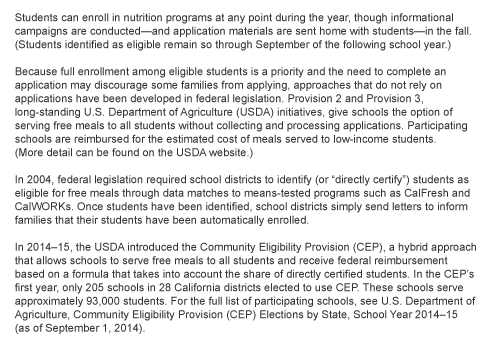
Using self-reported income and family relationships from the California sample of a large-scale national survey of households, we can construct estimates of the number of public school students who are eligible for free and low-cost meals.12 Approximately 58 percent of California’s public school students lived in such low-income families, compared to 53 percent of public school students in the rest of the U.S. (Figure 1). A comparison of the share of students who are low-income and the share enrolled in meal programs indicates high rates of enrollment: 56 percent of students were identified as eligible for free or reduced-price meals at the start of the 2012-13 school year in California, compared to 50 percent of students in other states. From this evidence, California appears to be on par with the rest of the nation, and there appears to be high enrollment among low-income students.
Figure 1. California is on Par with the Rest of the Nation in Identifying Students as Low Income
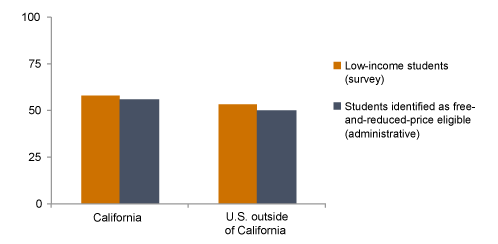
SOURCE: Author calculations from the American Community Survey (2012) and the National Center for Education Statistics, Common Core of Data (2012).
NOTE: Estimates refer to students enrolled in K-12 public schools..
Nonetheless, poverty does vary across the state. Figure 2 maps the share of students identified as low-income across school districts in the state. Most students (73.6%) were enrolled in districts where at least 40 percent of students were low income.13 Only 8.7 percent of students attended school in districts where 20 percent or fewer of students were identified as eligible for free and reduced-price lunch.
Figure 2. The Share of Students Identified as Eligible for Free and Reduced-Price Lunch Varies Across the State
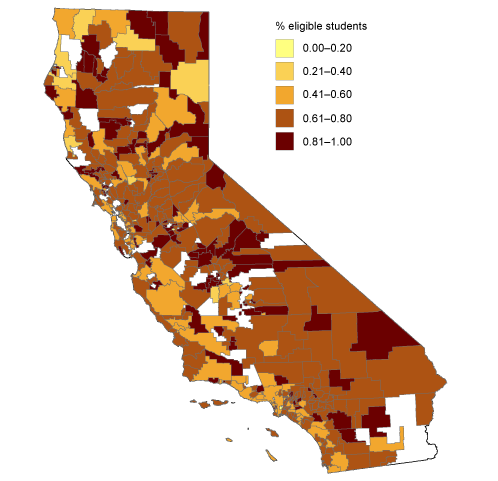
SOURCE: Author calculations from CDE summary administrative data. See Technical Appendix A for details.
NOTE: Ratios refer to October 2012. Unshaded areas reflect districts with current, districtwide Provision 2 or Provision 3 status and a few instances of missing data.
How Many Low-Income Students Participate in School Lunch?
Enrolling all eligible students in NSLP (and other school nutrition programs) is a fundamental objective, but full participation is also critical. In fall 2012 an average of 72.1 percent of eligible students participated in free or reduced-price school lunch programs statewide.14 Figure 3 maps participation among low-income students across school districts in the state. In most districts, participation among low-income students ranged from 60 percent to 80 percent.15 These districts enrolled 60.3 percent of the state’s public and charter school students. However, 23 percent of students were enrolled in districts where participation was lower (for most, between 40 percent and 60 percent), and only 16.7 percent of students were enrolled in districts with 80 percent to 100 percent of students participating.
Figure 3. The Share of Enrolled Students Who Participate in Free and Reduced-Price Lunch Programs Varies Across the State
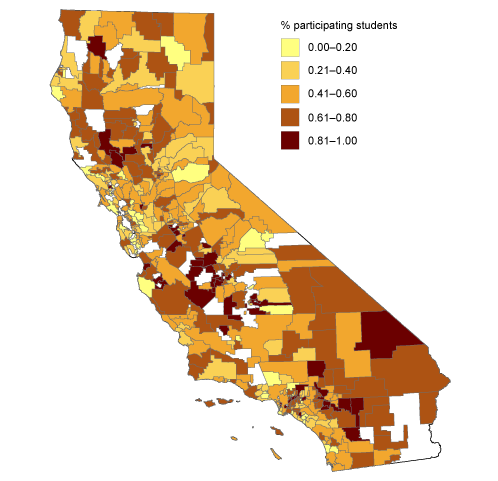
SOURCE: Author calculations from CDE summary administrative data. See Technical Appendix A for details.
NOTE: Ratios refer to October 2012. Ratios greater than 1 are recoded to 1. Unshaded areas reflect districts with current, districtwide Provision 2 or Provision 3 status and a few instances of missing data.
It is difficult to observe attitudes or beliefs that deter individual students from participating.16 We can, however, assess whether the differences we have seen in enrollment and participation across the state are systematically linked to school- and district-level characteristics.
What Factors Are Linked to Enrollment and Participation?
Individual students are eligible for free or reduced-price meals if they have a special status or if their families indicate they have incomes under the eligibility ceiling or are participating in CalFresh or CalWORKs. In other words, poverty status is the essential factor that makes a student eligible. To determine whether factors other than poverty that might affect enrollment and participation, we use quantitative models to assess the relevance of several school and district characteristics: school grade range, school size, district size, district type, and the share of the district population that is foreign born.17 Even if one or several of these factors is relevant, this does not imply that the factor specifically lies behind the difference. Nonetheless, the information can inform efforts to boost program enrollment and participation.
Not surprisingly, schools in districts with higher poverty rates identify higher shares of needy students. Such schools also see higher participation among identified needy students in school lunch programs. While this is positive news from the point of view of serving California’s vulnerable children, it also indicates that districts in wealthier areas may need to pay attention to participation among their smaller populations of low-income students.18
It is worth investigating the possibility that parents who are not U.S. citizens are reluctant to submit applications for, or allow their children to participate in, free or low-cost meal programs (although citizenship is not a criterion for eligibility). It is also possible that enrollment is affected by language or cultural barriers. We find no evidence of lower meal program enrollment in districts with higher shares of foreign-born residents, but we do find that participation is roughly 4 percentage points lower in these districts relative to districts with low shares.
It is also worth examining concerns about low-income older students being less willing than low-income elementary school students to enroll and participate in free and low-cost meal programs. We examine this question in several ways. Do schools that serve younger children have systematically higher free-and-reduced-price-meal populations than schools that serve older children? Do districts that serve younger versus older children see systematically higher low-income student enrollments? And, finally, do students enrolled in higher grades within the same school have systematically lower levels of enrollment in school nutrition programs compared with younger students in the same school?19
We find no clear evidence that low-income high school students are systematically under enrolled in school meal programs as compared with elementary school students. But we do see evidence that older low-income students are less likely to participate in school lunch than younger students.
Finally, we consider the link between enrollment and school size. Because of the fixed costs of staff and infrastructure, larger districts and schools may have greater capacity to enroll and serve low-income students. In fact, we find the opposite. While we do not see evidence that district size (as measured by total student enrollment) matters, smaller schools (again, as measured by total student enrollment) do see higher rates of both identification of and participation among low-income students (Figure 4). For example, relative to schools that enroll roughly a thousand students or more, schools that enroll approximately 400 students or less have enrollment rates among low-income students that are 11.5 percentage points higher and 8.7 percentage points higher participation in school lunch (again, among low-income students). The differences are smaller for mid-range schools as compared with small schools, but they are still negative.
Figure 4. School Lunch Enrollment and Participation Among Low-Income Students is Higher in Smaller Schools
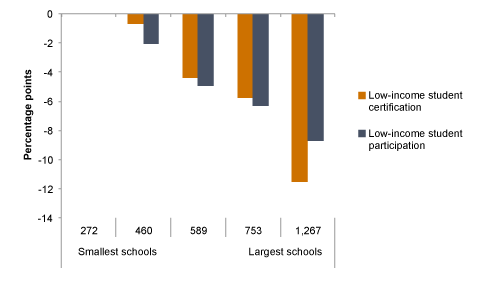
SOURCE: Author calculations. See Technical Appendix A for data sources and technical appendix Table B1 and the accompanying discussion for details of the quantitative models.
NOTE: Schools are divided into five equal groups. The X-axis labels show total school enrollment at the midpoint of each of these groups.
Many of our findings are reassuring-for example, high school students do not appear to be systematically under enrolled. But it appears that schools with larger enrollments would benefit from engaging in additional outreach around paper applications and/or stepped-up efforts to automatically enroll eligible students.
Policy Implications
NSLP has been in place since the 1940s; LCFF is a recent reform. Both have the goal of improving outcomes among disadvantaged students. LCFF provides additional funds to districts with higher shares of disadvantaged students, including those enrolled in school nutrition programs. NSLP encourages schools to enroll low-income students and to serve them nutritious meals. If certain types of schools and districts see systematically lower enrollment and participation, equity in achieving these goals becomes a concern. We find indications that such systematic differences do exist across schools in California. While it may not be possible to identify the precise underlying reasons for these differences, decisionmakers at both the state and local levels can consider means of reducing application burdens and improving outreach, particularly for categories of schools that appear to be particularly at risk for under enrollment or under participation
Certainly, persisting in efforts to automatically enroll low-income students who are enrolled in other safety net programs also holds promise.20 Reducing the share of students who must submit applications for free or reduced-price meals is an important part of a larger statewide effort, spurred by the Affordable Care Act, to integrate social safety net services and programs.21 Increasing the coordination of information technology systems that enable all eligible Californians to enroll in safety net programs can help the state achieve a number of important goals, including those of the NSLP and LCFF.
Related reports are available on ppic.org: Paul Warren, Implementing Local Accountability in California’s Schools: The First Year of Planning and Laura Hill and Iwunze Ugo, Implementing California’s School Funding Formula: Will High-Need Students Benefit?.
Technical appendices to this report are available on ppic.org.
Topics
Health & Safety Net K–12 Education

